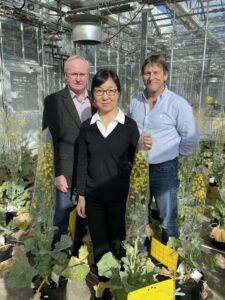Promising research shows a canola yield increase of a whopping 250 per cent in experimental plants.
Future canola crops could see big yield gains thanks to innovative work at the University of Guelph (U of G).
Initially, Michael Emes and Ian Tetlow, biochemists and professors at the U of G Department of Molecular and Cellular Biology, transferred a starch-branching corn enzyme into model plant Arabidopsis to see if the plant could form starch in its leaves.
“We did that primarily to test some hypotheses we had about the way starch is made,” Emes says. “Starch in and of itself is an important product.”
They replaced gene codes for enzymes that determine the degree of branching and chain length of the starches.
When those plants grew, the scientists observed surprising results compared to the unaltered parents. Emes explains the plants were twice the size, produced four times the siliques (seed pods) and had an overall yield increase of approximately 250 per cent. The modified plants exhibited a remarkable increase in both flower production and seed count. While a standard Arabidopsis plant usually yields around 11,000 seeds, those that were genetically engineered to contain the corn enzyme significantly surpassed this figure, producing more than 50,000 seeds.
Importantly, the oil profile didn’t change through this process.

(:-Rt) Michael Emes, Liping Wang and Ian Tetlow work together at the University of Guelph creating transgenic canola utilizing corn genetics. Photo: University of Guelph
Arabidopsis isn’t a crop, but a model plant that’s genetically similar to canola. While the genes are virtually identical, canola is a more complex plant than Arabidopsis. The researchers say replicating the study results in canola could greatly benefit agriculture. With funding from Genome Canada and the Canola Council of Canada, they began the process.
Emes and Tetlow asked Liping Wang, research associate at the University of Guelph, to bring her high-level molecular genetics knowledge to the project.
The scientists initially identified two genes in Arabidopsis to knock out, but then realized that in their specific canola cultivar, they needed to knock out six genes. Wang used a combination of clustered regularly interspaced short palindromic repeats (CRISPR) to knock out those genes and traditional GM techniques to insert the maize genes.
They saw significant improvement in the transgenic line compared to the control when the canola was grown. Silique numbers increased from 200 to 300, the number of stems increased from five to 10, and they observed an average increase of 50 per cent in seed weight. With all factors considered, they saw an overall yield increase of up to 50 per cent.
Another interesting observation in both Arabidopsis and canola was that the experimental plants’ stems were approximately 50 per cent thicker than the parent plants. The bonus is a significant yield increase and significant drought tolerance in the resulting plants.
“I was excited to see validation in terms of both yield and potential for drought resistance,” Wang says. “Right now, climate change is a very urgent thing. I remember years ago in Saskatchewan, it was 33-34 C in the summer, and canola doesn’t like that heat. The yield significantly dropped.”
Wang explains that the goal is to provide both drought resistance and yield increase in canola.
Wang did some experiments mimicking drought by increasing the temperature to 29 C from the control of 22 C as well as withholding water. The control lines suffered, and the CRISPR edited lines also suffered, but not nearly as much.
The cultivar the researchers are using is already blackleg resistant, but not herbicide tolerant.
“This cultivar isn’t herbicide tolerant. So that’s something else that we need to engineer into this, which is not difficult, but adds another step,” Emes says.
Emes says the team will also analyze the canola oil profile, but as the Arabidopsis had no change to its profile with gene editing, they don’t anticipate any changes in canola.
While the team is excited about the results they’ve seen, and they have obtained an American patent for the process, they’re already looking toward other applications of this discovery. Understanding the why behind the results is key.
“If we can understand the mechanism that’s occurring in canola and the Arabidopsis plant, we might be able to translate that to other crop systems as well,” explained Tetlow. “There are likely similarities in the mechanisms by which plants sense sugar and how they how they respond to that at the physiological level.”
The researchers are working to understand this at the molecular and biochemical level, with an eye on the potential to repeat this process in other crops.
“We have a very simplistic hypothesis as to why we think this is occurring,” Tetlow says. “Part of that is we think the plant is sensing it’s got more carbon than it normally has at that point in its growth cycle. So understanding carbon reserve storage and sugar release, is I think, key to this.”
At this point, experiments have been confined to controlled growing environments. Temperature, humidity and light are all regulated. To be useful for agriculture, the crop needs to perform well in real world conditions, so the next step is field trials. The team plans to carry these out in Saskatchewan, Manitoba, Ontario and possibly in Montana.
This study is now part of the Agriscience Research Cluster for Canola, funded by Canadian government.
“Field trials will happen over the next three seasons, and we’ll see how they do in an environment where we can’t control everything,” said Emes.
Emes expects it will take around ten years before this line could be commercially available.
Header photo — (R-L) The experimental transgenic canola has increased stem count, seed pods, stem thickness and up to 50 per cent greater yield than the control plants). Photo: University of Guelph
Related Articles
Feds Give Money to Create Canola Cluster
Does Wider Canola Row Spacing Optimize Returns… Or Risk Consequences?





